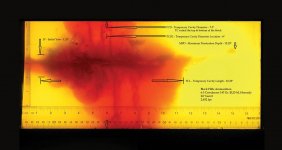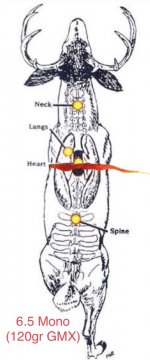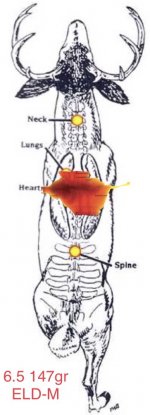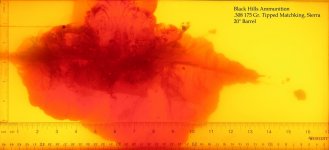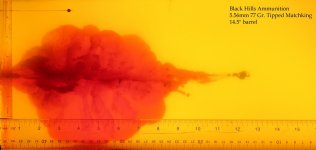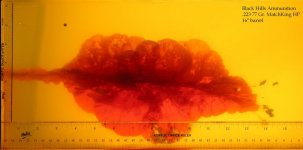Let's touch on hydrostatic shock. I know that term has been tossed around, or kicked around perhaps, quite a bit. You said shock doesn't exist. I don't know what the term is, but the force that creates the temporary cavity is what I think most people refer to when they refer to shock. What is the proper term for the force that causes the temporary cavity.
To be clear, that was a quote from Martin Fackler. In terminal ballistic circles, the main ideas behind “hydrostatic shock”, “hydraulic shock”, etc., are due to high impact velocity there is a “shockwave” or “electrical impulse” that is sent outward from the bullet that can damage arteries or even brain function far from the wound track. Imagine a pressure wave of blood in arteries being sent back to the heart and brain from the “shock” that ruptures those organs. Or something similar. In the above case, no “hydrostatic shock” has not proven to be contributing factor to wounding in any legitimate medical research, let alone that it even exists.
As for what the force that causes the ten port cavity is called, velocity. In so much as I can recall, I don’t think there is a specific term for it. It’s just the TC (temporary cavity.
A quote from Dr. Gary Roberts-
The tissue surrounding the permanent cavity is briefly pushed laterally aside as it is centrifugally driven radially outward by the projectile’s passage. The empty space normally occupied by the momentarily displaced tissue surrounding the wound track, is called the temporary cavity. The temporary cavity quickly subsides as the elastic recoil of the stretched tissue returns it towards the wound track. The tissue that was stretched by the temporary cavity may be injured and is analogous to an area of blunt trauma surrounding the permanent crush cavity. The degree of injury produced by temporary cavitation is quite variable, erratic, and highly dependent on anatomic and physiologic considerations. Many flexible, elastic soft tissues such as muscle, bowel wall, skin, blood vessels, and empty hollow organs are good energy absorbers and are highly resistant to the blunt trauma and contusion caused by the stretch of temporary cavitation. Inelastic tissues such as the liver, kidney, spleen, pancreas, brain, and completely full fluid or gas filled hollow organs, such as the bladder, are highly susceptible to severe permanent splitting, tearing, and rupture due to temporary cavitation insults. Projectiles are traveling at their maximum velocity when they initially strike and then slow as they travel through tissue. In spite of this, the maximum temporary cavity is not always found at the surface where the projectile is at its highest velocity, but often deeper in the tissue after it has slowed considerably. The maximum temporary cavitation is usually coincidental with that of maximum bullet yaw, deformation, or fragmentation, but not necessarily maximum projectile velocity.
We had a crappy weather weekend, so i found some rabbit holes to go down. Interestingly two of them led back to your writings. One was from 2012 over on the 'fire. It was from 2012 and you were singing the praises of bonded bullets. It seems like your experiences have steered you in a bit of a different direction since then. Something I didn't see mentioned above is heavy bone busting. Is that something you avoid with match bullets?
Not sure of the context of what I wrote specifically, but a couple of points about then and bonded bullets. In 2012 I was still shooting mostly magnums except for the 243 and 308. Some of the bullets didn’t exist then, that do now. Even still, the primary projectiles that I used for hunting then was the 178gr AMAX from 300 mags, 168gr AMAX from 308’s, 95gr NBT from 243’s, and 62/64gr Fusions/Gold Dita from 223’s. Lots of others were used as well, but those made up the majority. I didn’t and don’t generally recommend extremely frangible bullets in bigger cartridges because almost no one is happy with the excessive meat loss that results. The 243/95gr NBT got a lot of use then because it was the smallest (at the time) combination that killed quickly with acceptable penetration for all around hunting from 0-500’ish yards. The options commonly available then for 223/5.56 killed just fine out to 300’ish yards, but were not what I considered a solid replacement for the bigger rifles for all around hunting, hence some tending towards harder bullets for the bigger rounds. The 77gr TMK changed that (2014 if I recall), and since then has been the primary cartridge and bullet combo that I and most of those I’m around use for everything.
As for Bonded bullets themselves, they can be fantastic. Most combine a good balance of weight retention for penetration even through barriers (heavy bone in this case) with rapid and wide expansion for increased wound size. Speaking of medium to large game hunting, they are probably the best overall choice for most hunters from close in to around 400’ish yards. The problem with bullets such as ELD’s/TMK’s/etc. is often severe meat damage. They kill dramatically, but any bone hits at high velocity results in a lot of lost meat.
Let’s look at the other side- monolithic solids such as Barnes TSX/TTSX, Nosler E-Tip, Hornady GMX, etc. I have, and do use deep penetrating bullets like these quite a bit. They have their place, but they create deep, relatively narrow permanent wound channels with very little secondary wounding effects. Between hunting, crop damage, etc. I have killed and seen killed hundreds upon hundreds of medium and large game with lots of bullets. For instance, years ago in the span of a few weeks I used an at the time, new mono bullet to kill 30+/- deer at a variety of impact speeds. Measured, logged and took pictures of the placements, wound channels, distance traveled after hit, and approximate time to incapacitation. Then I used the same rifle and cartridge with a different newer bullet for the same amount of deer and compared the results. The differences were readily apparent to all- the mono killed slower at ranges, animals traveled farther with all non CNS hits, and they stayed on their feet longer after lethal hits. A couple of animals with both bullets were non lethal, or non immediately lethal hits, and the differences in the time to recovery, distance traveled and animals reaction were striking. Granted, 60’ish animals is a relatively small sample size however two animals we’re shot at identical ranges, as in within in a few feet of each other, and in near identical placements and angles (broadside, guts). The one with the mono turned into a rodeo that had to be tracked for a very long distance with multiple shots to finish. The one with the rapidly fragmenting bullet ran something like 60-70 yards and died. The temp cavity and fragmentation had ruptured the diaphragm. That’s just one group of samples.
The only place that I see a use for deep penetrating bullets of any sort for general hunting is when there is no other type of bullet in a given scenario that will achieve adequate penetration, or when meat damage is trying to be limited as much as possible. That leads us back to bonded lead core bullets, as well as thick jacketed non bonded bullets. For most people, they offer an adequate combination of penetration and wound
The other rabbit hole was a scope rabbit hole that led me back here to your Optika 6 test. It's crazy what goes into a test of a single example. I notice that you don't mind naming scopes that perform well, but I rarely see you mention the name brand of those poor performers, though I thing I can sometimes infer. Do you stand to piss too many people off? At any rate, I love those tests and would love to see more. That info could go in your book! It's a shame that there's not a way to machine replicate the forces. Somewhere out there is an engineer that could save you some of the time you invest in beating up scopes. The forces would be consistent and repeatable as well.
There is a way to test it mechanically and it has been done. However it’s expensive, I don’t own it, I can’t show the results, it can’t be used at the range, and people don’t have it to replicate fit their use. The drop tests, etc. were the initial proving grounds of scopes failing before they did so in actual use. Then legitimate testing was conducted that proved what was found by the drops with rifles. Since the results are repeatable and predictable, for personal use the rifle drops are very simple and easy to do, they’re repeatable and have consistent results, and show whether a scope will or not.

